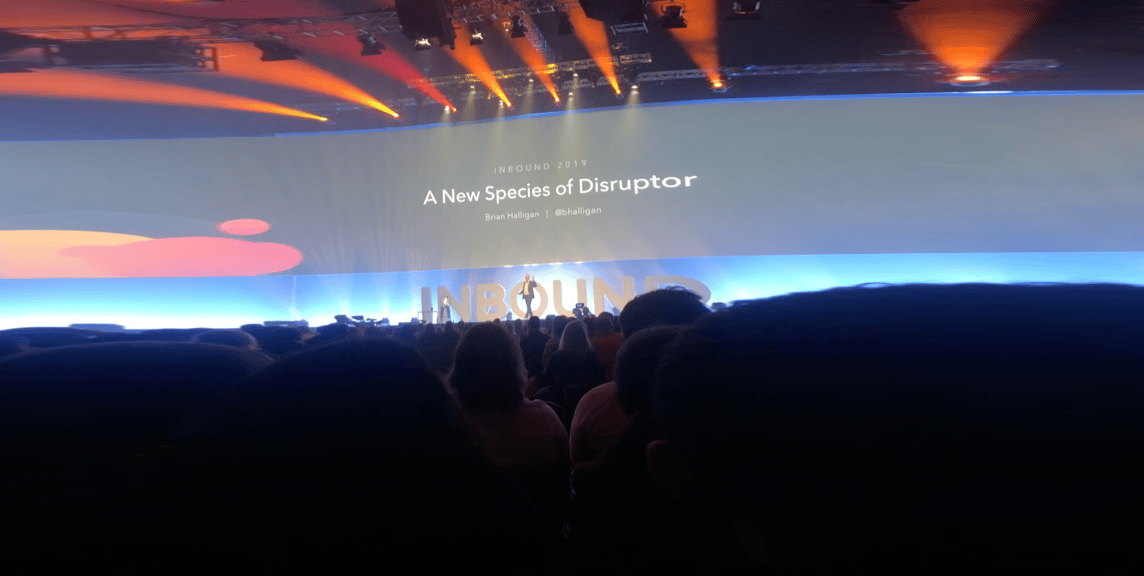
Alexander is a content creator who has a great interest in learning new things. What he enjoys even more is creating knowledge content.
Keep me updated!
Subscribe

In early September, I attended the event INBOUND19 together with my two colleagues, Elin and Stellan. Along with the other 26,000+ marketers, we took part in new insights, lessons and best practices. Here are some of my reflections from our journey to Boston.
A new species of disruptor
The two founders of HubSpot, Brian Halligan and Dharmesh Shah are known for delivering inspiring presentations with great charisma. This year was no exception. Brian opened up with a talk about a new species of disruptors. During the past year, he and some colleagues have closely examined what differentiates disruptors from incumbents.
In their research, they have divided disruptive companies into two categories. In the first category, we find companies like Google, Apple and Tesla. These companies are “technology disruptors”, as they are continuously introducing new technologies to the market. But what about the companies like AirBnB, Spotify and Netflix? Is it their technology that makes them successful?
Yes, parts of their success can probably be attributed to their technology. But according to Brian, these companies are rather “experience disruptors” than “technology disruptors”. More than anything else, they are disrupting markets by introducing a great customer experience. By interviewing founders and investors of several experience disruptors, they have found five traits of these companies.
While incumbents are looking for a product-market fit, experience disruptors are looking for an experience-market fit. In many industries, the service and products are similar among competitors, but by delivering a unique customer experience there are a lot of opportunities for growth.
Buying from an incumbent is complicated. The buying process is filled with friction like negotiations, specifications and long delivery times. The experience disruptors are fighting friction by replacing all the complicated steps in the customer journey.
Until now, most companies have worked with personas. But as companies get more and more customer data, there are new opportunities to offer a personalised experience. The experience disruptors are replacing traditional personas with data-driven personas, allowing them to create a unique customer experience.
Most companies sell their products directly to customers. But by creating a great customer experience the experience disruptors instead sell through their customers. Their customers promote their products to friends and families.
According to Brian, all companies have between 5 – 10 competitors. Most often these companies are offering the same things like price, quality and return policies. They are all business model followers. What the experience disruptors instead are doing, is breaking the business model down and see how they can add value to the customer.
The common conclusion of these success factors is - how they sell is why they win!
A company that several keynotes referred to during the inbound event was Carvana.com (only available in the US). They seem to do everything right. Carvana is an online used car retailer. Founded five years ago, they are quickly reshaping the way Americans buy cars.
Most of us are familiar with the friction-filled process of buying a car in the traditional manner. You go to a physical car dealership, talk to a salesperson, test drive, negotiate and after that, you need to deal with a lot of paperwork.
Carvana.com is now gaining popularity due to its frictionless customer experience. As a user, you go to their website, browse the cars, get approved for financing and place an order. Then you can choose to either pick it up in a car vending machine or get it delivered home. Finally, you can test it for a couple of days, and if you are not happy with the car, feel free to replace it. Sounds pretty simple, right?
Remember, how they sell is why they win.
We all have a responsibility to fight friction, meaning that we should always strive to make it easier for customers to interact with us. But how do you put it into practice?
To find out, I attended a session where Jon Dick, VP Marketing at HubSpot, shared how their mind-set has changed by implementing the flywheel at HubSpot. Press play below to get a summary of his practical tips on how to make the flywheel spin faster by creating a great buying experience.
*CTR: Click-through-rate
